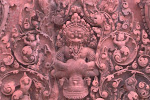| Kampot's cave temples make for a magical trip |  |  |
| Written by Stephanie Mee | |
| Thursday, 18 June 2009 The Phnom Penh Post | |
| Long believed to be magical sites, Kampot’s temples are safeguarded by pious elderly men and women, and scores of knowledgeable children  Photo by: Stephanie Mee Loak Ta Neak Sohlor or 'Grandfather White Dragon'. DEEP within the limestone karsts scattered across Cambodia's Kampot province lie networks of cave temples, some of which have been used for centuries as centres of Hindu and Buddhist worship. Long believed to be magical and spiritual sites, today the temples are safeguarded by pious elderly men and women, and scores of small children. Just eight kilometres east of quiet Kampot town lies Phnom Chngouk, one of Kampot's oldest known cave temples. The winding dirt road to the temple snakes past scenic views of the Cambodian countryside, lush with rice paddies, small farms and dramatic limestone formations, covered in dense vegetation. Shortly before the muddy footpath to the base of Phnom Chngouk, packs of smiling schoolboys lie in wait, leaping at the chance to offer their services as tour guides to the cave in the hopes of bringing in extra income for their families, many of whom are local farmers. Phnom Chngouk itself is a hulking limestone karst, which contains many hidden chambers, rocky outcrops and stalactites, formed by calcium carbonate deposits in water. The largest cave contains an ancient red brick Hindu temple resting under a massive rock formation resembling an eagle. The temple was built in the 7th century, during the Funan period, and today is tended to by the elderly Loak Ta Neak Sohl, or "Grandfather White Dragon". "I came to this area 12 years ago to devote myself to the Buddhist dharma and meditate," Loak Ta Neak Sohl said. "At that time not many people knew about this temple; there were no steps up to the cavern, only forest and rocks. With my encouragement, the villagers pooled their money to build stone steps up to the temple." The slight, wiry patriarch explained that many electronic devices such as cell phones and watches cease to work in the cave, and that even airplanes and helicopters never fly over the site, as it interferes with their controls. Next to the main chamber is a passageway that leads to the interior of the cave. The path is slippery and dark, and littered with large boulders, a stalactite resembling the head of a cow, and a cool, subterranean pond filled with tiny black fish. The journey through the cave and out to the rice fields below and behind the mountain is easily negotiated by the young boys who hop effortlessly through the obstacles with only a flashlight. But it is not an easy trip for first-time visitors. "Tourists don't often explore this cavern, as they are too scared," said 16-year-old Sun Pet, who comes to the cave and offers his services as a tour guide whenever he has free time. "If people want to go, I take them through, but only if they are under 80 or 90 kilogrammes, as some of the passageways are too tight for larger visitors."  Photo by: Stephanie Mee Cave Buddha shrine at Wat Kirisan. Further down the road from Phnom Chngouk is Phnom Sorsia, or White Elephant Cave, a small hill that houses an impressive modern wat and a number of small underground chambers. Local teenage boys point visitors towards the main cavern where a large rock formation in the shape of an ele- phant glitters with mineral deposits in the low light. Man-made steps hewn into the dank stone of the cave lead down to a crevasse, where sunlight pours in through an opening in the roof of the cave, and a thin ledge juts out, creating a precarious walkway over a chasm and out to the back side of the hill. Arguably the most interesting of Kampot's unique cave temples is Wat Kirisan, located in Kampong Trach, 29 kilometres from Kep. Twelve-year old Lu Tak is a fount of information when it comes to Wat Kirisan. Armed with a flashlight, he leads visitors down the temple steps and under the mountain into a channel carved out by a now-defunct river. "During the 1970s, the Khmer Rouge used the soil in this cave for the rice paddies nearby because it was full of minerals," he said. "Later, Vietnamese soldiers hid in the caves, but the Khmer Rouge found them and killed them. Some Vietnamese officials returned to collect the bones, but many of their bones still remain in hidden recesses." Ten metres on, the channel opens up into a wide clearing, a hidden garden open to the sky and surrounded by towering walls of limestone. Around the perimeter of the rock walls are grottoes, carved by ancient streams, which contain multiple Buddhist and animist shrines. Some of the grottoes lead to vast underground caverns with lunar-like landscapes and echo with the eerie sound of water softly dripping into the underground pools. Magical powers "Years ago my auntie Diep was very sick and she had a dream that Loak Ta Ey Sey, the spirit of the forest, told her to come here and pray and she would get better. She obeyed and immediately got better, so now people come here to pray to the forest spirit for health, wealth and better life," Lu Tak said. As for Lu Tak, he believes in the spirit's powers but rarely asks it for favours. |


1 comment:
Hey Steph
Fantastic writing
You should send this off to the Globe and Mail or other Canadian papers
Great stuff
Your Dad
Post a Comment